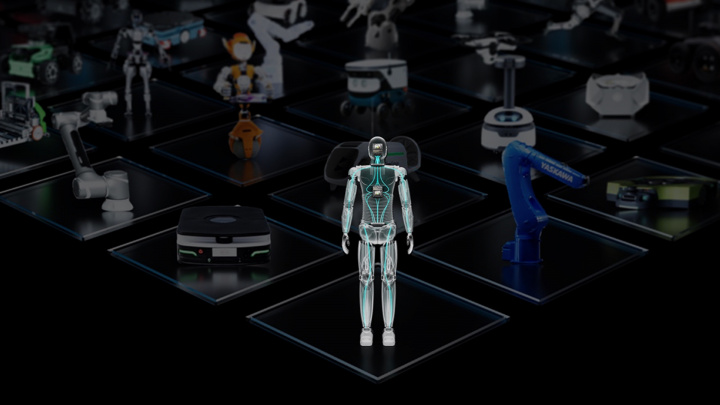NVIDIA Accelerates Humanoid Robotics with Project GR00T and Jetson Thor
NVIDIA, a leader in AI computing, is significantly ramping up its efforts in humanoid robotics with the announcement of Project GR00T. This initiative aims to create a general-purpose **foundation model** specifically designed for humanoid robots. Coupled with significant updates to the NVIDIA Isaac robotics platform and a new computing platform, this project signals a major push to pave the way for more capable, intelligent, and versatile humanoid robots in the future. But what does this entail technically, and is it a true game-changer or a strategic marketing move?

The Core Components: GR00T Model and Jetson Thor
At the heart of the initiative is the **GR00T (Generalist Robot 00 Technology)** model. Unlike traditional robot programming or task-specific AI models, a foundation model is trained on vast amounts of diverse data (likely encompassing simulation, video demonstrations, and teleoperation data) to acquire broad, general-purpose skills. For GR00T, this means enabling robots to understand natural language commands, observe and mimic human movements (learning complex coordination and dexterity), and interact more effectively and safely with the unpredictable real world. The goal is to provide a base intelligence that robotics companies can then fine-tune for their specific hardware and target applications.
Powering these advanced models directly on the robot requires immense computational power. To address this, NVIDIA introduced the Jetson Thor computer, specifically designed for humanoid robots. Built upon NVIDIA's powerful Thor system-on-a-chip (SoC), originally developed with demanding automotive applications in mind, Jetson Thor is engineered to handle the complex, real-time processing required for humanoid operation. This includes processing data from numerous sensors (cameras, lidar, force sensors, joint encoders), running sophisticated AI models like GR00T for perception and decision-making, and executing intricate motion planning and control algorithms – all within the power and size constraints of a mobile robot.
The Ecosystem: Isaac Platform Updates
NVIDIA understands that hardware and a base model alone are not enough. Project GR00T is deeply integrated with major upgrades to the NVIDIA Isaac™ robotics platform, providing the essential tools for developing, training, and deploying these advanced robots:
- Isaac Sim: Enhanced simulation capabilities are crucial. Training robots, especially humanoids, in the real world is slow, expensive, and potentially dangerous. Isaac Sim allows developers to create realistic virtual environments to train GR00T and other AI models safely at scale, generate vast amounts of synthetic data, and test robot behaviors under countless scenarios before deploying them physically.
- Isaac Lab: Specifically mentioned for reinforcement learning (RL), Isaac Lab likely provides specialized tools and environments within Isaac Sim optimized for training robots through trial-and-error in simulation.
- OSMO: A new compute orchestration service. Training large foundation models and running thousands of parallel simulations requires managing complex workflows across diverse computing resources (cloud, local clusters). OSMO aims to streamline this process, scaling the development pipeline efficiently.
- Generative AI Tools: The platform incorporates generative AI models not just for the core GR00T intelligence but also potentially for generating realistic simulations, creating varied training data, and enabling robots to produce more natural and context-aware motion sequences.
This comprehensive suite aims to provide an end-to-end solution for companies building sophisticated robots, significantly lowering the barrier to entry and accelerating development cycles.
Strategic Significance: Hype vs. Reality
NVIDIA's push into humanoid robotics is strategically significant. By providing the core AI model (GR00T), the powerful onboard computer (Jetson Thor), and the development/simulation tools (Isaac), NVIDIA is positioning itself as the fundamental **enabling platform provider** for the burgeoning humanoid robot industry – akin to providing the "picks and shovels" during a gold rush. Collaborations with leading humanoid companies like Agility Robotics, Apptronik, Boston Dynamics, Figure AI, Sanctuary AI, Unitree Robotics, and XPENG Robotics (as announced by NVIDIA) lend credibility and suggest broad industry interest.
Is it a guaranteed revolution? The potential is enormous. A standardized, powerful platform could dramatically accelerate progress, allowing robot companies to focus on hardware innovation and application-specific behaviors rather than reinventing the AI wheel. However, significant challenges remain. Humanoid hardware (actuation, power efficiency, robustness, cost) is still evolving. Creating a truly "generalist" AI model that performs reliably and safely in the complexities of the real world is an immense undertaking, far beyond current capabilities. There's also a clear business incentive for NVIDIA: the more complex the AI, the more powerful (and profitable) the GPUs and compute platforms needed to train and run them. Therefore, while GR00T represents a serious and potentially transformative effort, it's also a long-term bet intertwined with NVIDIA's core business strategy. The immediate impact might be more about empowering researchers and developers than deploying armies of capable humanoids tomorrow.
Conclusion:
NVIDIA's Project GR00T and the associated Jetson Thor platform represent a significant commitment to advancing humanoid robotics. By aiming to provide a foundational AI model and the necessary hardware and software ecosystem, NVIDIA seeks to accelerate the development of more intelligent and adaptable robots. While the vision of general-purpose humanoids is still distant, this initiative provides powerful tools that could substantially shorten the path, solidifying NVIDIA's central role in the future of embodied artificial intelligence.